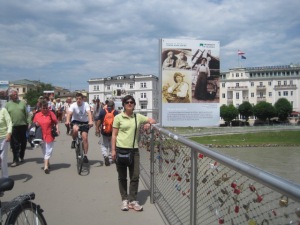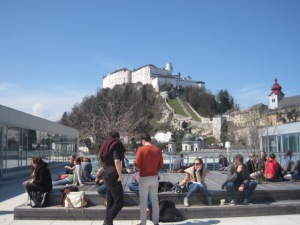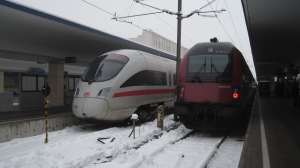Perhaps the physical presence of a history that stretches across many centuries and several continents makes Austrians take note of what came before more often than U.S. Americans. To understand that one’s homeland was once larger, stronger, greater, is elemental to being an heir to Habsburg history. The borders ballooned and shrank over hundreds of years, leaving a remnant for the vanquished after the world wars of the twentieth century. Policy mavens of today use that long history to promote linkages, to improve Austria’s international position. My final sojourning days in Europe included travel to several former Habsburg locations in northern Italy, Hungary, and Germany as well as introducing my family to the imperial grandeur of Vienna. It seems an unending balancing act, to accept the changed status gracefully—to still appreciate and make the best of the past in the present. And so I officially end my sojourning blog, a former Fulbrighter, writing from a part of Florida once under the Habsburg realm.
Tag Archives: history
Return Migration
The plane landed at midnight. My Fulbright stands now a fait accompli, those final days of the semester, filled to the brim. One of the last stops included a stroll across the river. Colleagues in Salzburg, with a little help from the City Archive and Integration Bureau, designed a wonderful exhibit about coming, going, and staying—a history of migration to and from the region. It decked one of the pedestrian bridges across the Salzach, telling the stories of those who left as well as those who came, linking the past and the present, domestic servants and archbishops. Tourists could pause, school classes could read, and locals could contemplate as they passed pictures of traders in Venice, Protestants exiles, and guest workers. One of the panels noted the thousands of students and professors who came during the 17th and 18th centuries to the University of Salzburg, and the 112 countries now represented among those who attend. I now join that history. The exhibition came down about the same time I left town to travel with my family, exploring surrounding lands, and then to return to my home in Florida.
Bordering change
As the U.S. Congress debates immigration reform, border control sparks heated political rhetoric. In my lifetime the trajectories of border security in North America and Europe moved in opposite directions. When I was a child in Michigan my family would sometimes take a Sunday drive to Canada for lunch. At the border the officials looked at the driver’s license and welcomed us, or they just waved us through. My last trips to Canada required a passport and interrogation in both directions across a clearly militarized frontier. On the other side of the ocean: during graduate school when I first visited Austria every neighboring nation enforced its boundaries. We collected passport stamps and compared stories of questioning and delay. The end of the Cold War, expansion of the EU, and more specifically the Schengen Agreement contributed to the opening of many of the borders within Europe. No more going through a passport check to travel from Austria to Germany. From Salzburg you can easily see Germany, even walk across the largely invisible border. The shift towards greater freedom of movement here contrasts the increasing limitations on that freedom surrounding the United States.
The T-word
You too may mutter the T-word under your breath at times. I do often. Technology lures with promises of instant contact, reaches into our pockets for increasing shares of the purse. But does it deliver? Coming from and living in “fully” interconnected places does not mean connections exist or the devices that sustain them function. The hours and energy I spent trying to bring a literal T-stick to do its designated task, to connect my home computer to cyberspace, lost. Multiple other “flukes” required technological knowledge I neither possessed nor could understand when tech consultants tried to explain (to our increasing mutual irritation). My virtual phone conversations croak, sputter, and die. At least in my memory of sojourns past, land lines operated better. My son and I wrestle regularly with a transatlantic online school world that works often, but not always. Making school exciting—flash!–means making it slow or no go for a meager modem. For relief I think of the North American correspondents of the 1600s, who sent three versions of one letter with different ships across the Atlantic in hopes that one would arrive. “Good connections” meant that message arrived and the writer received an answer–one letter in each direction in the course of the sailing season. The expectation of instant, visual, in-person quality: these cause my frustration.
University Time
The rooms where I teach overlook the Salzach River. Computer terminals and internet connectivity contrast the marble columns that frame the stairwells. The University of Salzburg presents many such juxtapositions, from the map gallery in the law school (circa. 1600) to the Unipark complex, a modern setting for study, lecture, and other functions, right up to the terrace classrooms and café. Unipark officially opened last year as part of the 50th/390th anniversary celebration. Two dates? The university, founded in 1622, functioned until 1810, then downgraded and reorganized as part of annexation to Bavaria—the politics of education. In the century-and-a-half interim that followed universities moved toward a greater focus on research to complement teaching. Salzburg the university reopened under a new initiative in 1962 bearing the name of its original founder: Paris Lodron. “University” here once implied theology, law, philosophy, and medicine. For Salzburg Catholic theology formed the core of both its founding and an important component of its rebirth. Not all other subjects fell under its offerings. The path from theology to cultural and social sciences, where I now reside, took a few years. Along the way a shift towards greater autonomy for each university assisted. In a country where anniversaries matter the University prepared an impressive program for the half-century mark a year ago. One part included the Altstadtfest [Old City Festival] which I attended while here for a guest lecture. New music, old settings: yet another demonstration of how history connects to today in this setting.
Travel
Lists, emails, last minute shopping: hectic days and nights. And then: wait, snack, fly, wait drink fly, wait snack fly. On some levels my journey to Austria echoes elements of travel from the past. In other ways technological innovation shifted the scope of knowledge and shortened the time frame. When I lay the map of today over an historical account I uncovered, the contour lines match at points only to diverge at others. The tale: one hundred years ago Dirk Pieter van den Burgh together with his family packed up their belongings and left their home in the Netherlands for Canada. * Their journey, chronicled in detail to the hometown paper, included periods of waiting, finding food, and encountering diverse people. Travel for Van den Burgh demanded patience, flexibility, and some chutzpah. Ditto today. His story recounted less than scrupulous travel agents, an unexpectedly long sojourn in Liverpool waiting for steamship departure, and then a rail trip that thankfully proceeded as expected. Compare today. Flight shortened my Atlantic transit time to two days compared to two weeks though it did not eliminate the possibility of vexing delays. Internet connections increased my scope of options and knowledge, though they did not eliminate those who prey upon migrants, now in virtual as well as meet space. Van den Burgh shared his journey in the media of his day, informing others of his experiences. I do the same only my messages arrive faster. As I see it technology has expanded the opportunities for impersonal assistance—and for impersonal fraud. I share Van den Burgh’s embrace of the new, frustration with unmet expectations, and occasional perplexity with the unknown. Gender separates us. Look for more on that another time. Meanwhile I slept in three cities in the past three nights, finding welcoming faces in each place. My mode of transportation transitioned to train, conveying me from Munich to Vienna. Orientation begins tomorrow.
*My study of the Van den Burgh reports and how descendants utilized them appeared in
Dutch-American Arts and Letters in Historical Perspective, Robert P. Swierenga, Jacob E. Nyenhuis, Nella Kennedy, eds., Holland, MI: Van Raalte Press, 2008.













